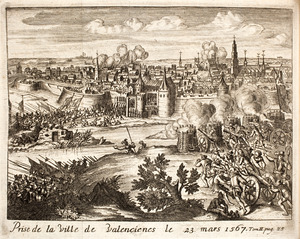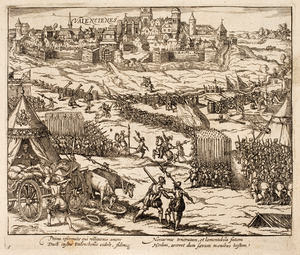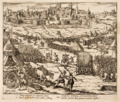Siege of Valenciennes (1567) facts for kids
Quick facts for kids Siege of Valenciennes |
|||||||
|---|---|---|---|---|---|---|---|
| Part of the Eighty Years' War | |||||||
 Capture of Valenciennes from Famiano Strada's De Bello belgico decades duae (reprint 1727). |
|||||||
|
|||||||
| Belligerents | |||||||
| Calvinist rebels | |||||||
| Commanders and leaders | |||||||
| Pérégrin de La Grange Guido de Brès |
Philip of Noircarmes | ||||||
The siege of Valenciennes was an important event in the Eighty Years' War. This war was a long fight for independence in the Habsburg Netherlands. The siege happened in the city of Valenciennes (which is now in France) from December 14, 1566, to March 23, 1567. Some people see it as the very first siege of the war.
Before the siege, a movement called the Beeldenstorm (meaning "statue storm") swept through the region. This was when Calvinists, who were Protestants, destroyed religious statues and images in Catholic churches. When the Beeldenstorm reached Valenciennes, Calvinist leaders like Pérégrin de La Grange and Guido de Brès took control. They made the city's defenses stronger. The government's leader, Philip of Noircarmes, tried to get the city back. After many failed talks, the city faced starvation. Finally, Noircarmes attacked with cannons, and the city surrendered.
Contents
Why the Siege Happened
Valenciennes was a very important city that fell under Calvinist control in 1566. Even before the Beeldenstorm arrived, the city's Catholic leader had been forced out. During the Beeldenstorm, Catholic priests were also expelled from Valenciennes.
The city council was still Catholic, but they were afraid to act against the Calvinists. This meant the Calvinists truly held power in Valenciennes. Two strong Calvinist preachers, Pérégrin de La Grange and Guido de Brès, led the movement. They encouraged many poor people and textile workers to stop working and listen to their sermons instead.
These preachers believed that everyone wanted to hear God's word. They thought a "heavenly kingdom" would soon arrive. However, the city's economy suffered greatly because so many workers stopped their jobs. The preachers did not seem to worry about the economy or the risk of the government trying to take back the city.
City Surrounded
Philip of Noircarmes, who was the acting governor of Hainaut, tried to talk with the leaders of Valenciennes. He wanted to bring order back to the city. Noircarmes demanded that the city's local soldiers, who had joined the Protestants, be sent home. He also wanted government troops to be stationed in the city to keep the peace.
The Catholic city council wanted to agree, but they were too scared of the Calvinist leaders. The Calvinists refused to let government soldiers into the city. Instead, they told the city council to make the city walls stronger. Valenciennes was a strong fortress city, so it could be defended well.
Because the city did not agree to his demands, Noircarmes declared Valenciennes to be in rebellion on September 17, 1566. In November, Noircarmes tried to avoid a costly siege. He asked the governor-general, Margaret of Parma, to stop all trade with the city. However, she wanted to try for a peaceful solution first.
When talks failed again, Noircarmes began to surround Valenciennes in late November and early December. He cut off the city from the outside world. On the night of December 5-6, 1566, de La Grange convinced the city's assembly to reject a royal army again.
Noircarmes' decision to declare the city a rebel was officially confirmed on December 14, 1566. A government order, called a placard, banned Valenciennes. People in the countryside were not allowed to trade or have any contact with the city. Carrying weapons and holding armed meetings were also forbidden. Anyone who broke these rules would be treated as an enemy of the king. This made the blockade much tighter. It became a siege, even though no cannons were firing yet.
The Siege Begins
At first, Noircarmes only surrounded the city without firing cannons. He wanted to avoid bloodshed. A group of Calvinists, led by Jan Denys, tried to help Valenciennes. But they were defeated by Maximilian Vilain, the commander of Lille, at the Battle of Wattrelos on December 27, 1566. Two days later, another group of fighters lost to Noircarmes near Lannoy.
Initially, the Calvinists in the city only had about 300 local soldiers. But by late 1566, they started arming the workers. Historians believe that at least 300, and possibly two or three times as many, workers fought for the city. Some historians have compared the Calvinist rule in Valenciennes to other religious movements of that time.
After the Protestant defeats at Wattrelos and Lannoy, the situation inside Valenciennes became very serious. Noircarmes made sure the city was completely cut off. When the governor also took control of Tournai on January 1-2, 1567, the Protestants in Valenciennes were almost completely alone.
Still, they kept fighting. They would often leave the city to find food in the surrounding areas. They would then return to Valenciennes with supplies. Some Catholic writers at the time were surprised that untrained civilians could last so long against government forces. The attackers tried to starve the defenders. They did this by destroying all the useful land and crops nearby. Protestant leaders told the "Geuzen" nobility (a group of Dutch nobles who opposed Spanish rule) that Noircarmes' forces were like terrible barbarians. They hoped to get outside help.
In early March 1567, Jan van Marnix gathered a Geuzen army to help Valenciennes. But this army was badly defeated at the Battle of Oosterweel on March 13. Margaret of Parma still had patience with Valenciennes. She sent Egmont and Aarschot to the city to try and make peace. But it was no use.
De La Grange, De Brès, and their allies spoke to them with great pride. Because of this, Noircarmes decided to start firing cannons at the city on March 20. The bombardment lasted for 36 hours. On March 23, 1567, which was Palm Sunday, the defenders finally gave up. Noircarmes entered Valenciennes on the same day.
What Happened Next
At first, De La Grange and De Brès managed to escape. But they were captured and taken to Tournai on March 31. The cities of Tournai and Valenciennes argued about who should put them on trial. Valenciennes won, and Tournai handed over the two prisoners. On May 31, 1567, De La Grange and De Brès were hanged in the market square of Valenciennes. Because Valenciennes surrendered, other Calvinist strongholds in the area quickly gave up too.
Images for kids
See also
 In Spanish: Asedio de Valenciennes (1566) para niños
In Spanish: Asedio de Valenciennes (1566) para niños




